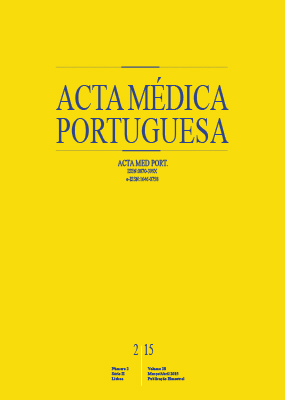Complex Congenital Heart Disease: The Influence of Prenatal Diagnosis
DOI:
https://doi.org/10.20344/amp.5753Keywords:
Heart Defects, Congenital, Prenatal Diagnosis.Abstract
Introduction: Complex congenital heart disease is a group of severe conditions. Prenatal diagnosis has implications on morbidity and mortality for most severe conditions. The purpose of this work was to evaluate the influence of prenatal diagnosis and distance of residence and birth place to a reference center, on immediate morbidity and early mortality of complex congenital heart disease.Material and Methods:: Retrospective study of complex congenital heart disease patients of our Hospital, born between 2007 and 2012.
Results:: There were 126 patients born with complex congenital heart disease. In 95%, pregnancy was followed since the first trimester, with prenatal diagnosis in 42%. There was a statistically significant relation between birth place and prenatal diagnosis. Transposition of great arteries was the most frequent complex congenital heart disease (45.2%), followed by pulmonary atresia with ventricular septal defect (17.5%) and hypoplastic left ventricle (9.5%). Eighty-two patients (65.1%) had prostaglandin infusion and 38 (30.2%)were ventilated before an intervention. Surgery took place in the neonatal period in 73%. Actuarial survival rate at 30 days, 12 and 24 months was 85%, 80% and 75%, respectively. There was no statistically significant relation between prenatal diagnosis and mortality.
Discussion:: Most patients with complex congenital heart disease did not have prenatal diagnosis. All cases with prenatal diagnosis were born in a tertiary center. Prenatal diagnosis did not influence significantly neonatal mortality, as already described in other studies with heterogeneous complex heart disease.
Conclusion:: prenatal diagnosis of complex congenital heart disease allowed an adequate referral. Most patients with complex congenital heart disease weren’t diagnosed prenatally. This data should be considered when planning prenatal diagnosis of congenital heart disease.
Downloads
Downloads
Published
How to Cite
Issue
Section
License
All the articles published in the AMP are open access and comply with the requirements of funding agencies or academic institutions. The AMP is governed by the terms of the Creative Commons ‘Attribution – Non-Commercial Use - (CC-BY-NC)’ license, regarding the use by third parties.
It is the author’s responsibility to obtain approval for the reproduction of figures, tables, etc. from other publications.
Upon acceptance of an article for publication, the authors will be asked to complete the ICMJE “Copyright Liability and Copyright Sharing Statement “(http://www.actamedicaportuguesa.com/info/AMP-NormasPublicacao.pdf) and the “Declaration of Potential Conflicts of Interest” (http:// www.icmje.org/conflicts-of-interest). An e-mail will be sent to the corresponding author to acknowledge receipt of the manuscript.
After publication, the authors are authorised to make their articles available in repositories of their institutions of origin, as long as they always mention where they were published and according to the Creative Commons license.









